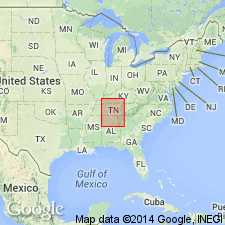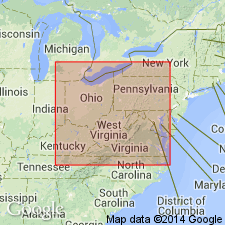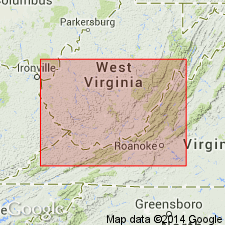
- Usage in publication:
-
- Center Hill bentonite bed*
- Modifications:
-
- Named
- Dominant lithology:
-
- Bentonite
- AAPG geologic province:
-
- Cincinnati arch
Summary:
Name Center Hill here applied to bentonite bed 0.05 ft to 0.14 ft thick about 2 ft below the top of the Dowelltown member of the Chattanooga shale in De Kalb, Putnam, and White Cos, central TN. Age is Late Devonian.
Source: GNU records (USGS DDS-6; Reston GNULEX).

- Usage in publication:
-
- Center Hill Ash Bed*
- Modifications:
-
- Revised
- AAPG geologic province:
-
- Cincinnati arch
- Appalachian basin
Summary:
Revised as Center Hill Ash Bed because smectite, a clay mineral present in bentonite, is not present in this unit. Is present in surface and subsurface of eastern TN in upper part of Dowelltown Member of Chattanooga Shale and in subsurface of TN, VA, WV, OH, and PA in Pipe Creek Shale Member of Java Formation.
Source: GNU records (USGS DDS-6; Reston GNULEX).

- Usage in publication:
-
- Center Hill Metabentonite
- Modifications:
-
- Areal extent
- AAPG geologic province:
-
- Cincinnati arch
Summary:
Center Hill Metabentonite is recognized in TN, KY, and IN at the base of Huron correlatives. Identified by presence of definitive pyroclastic mineral euhedra and mixed layer clays, associated with bone bed 16. In eastern Highland Rim of TN, unit occurs in uppermost part of Dowelltown, but in northern Highland Rim, TN, and in KY and IN, Center Hill was eroded and reworked into basal bed of lower Gassaway, called Bransford Sandstone (TN) and Morgan Trail Member of New Albany Shale (KY,IN).
Source: GNU records (USGS DDS-6; Reston GNULEX).

- Usage in publication:
-
- Center Hill Ash
- Modifications:
-
- Revised
- Areal extent
- AAPG geologic province:
-
- Appalachian basin
Summary:
Cross section between Norton and Asberrys, VA, in the Clinch Mountain outcrop belt shows more detailed divisions of Chattanooga Shale than previously indicated. Base of Chattanooga is marked by Belpre Ash, which occurs within the Rhinestreet Shale Member. Center Hill Ash occurs within the Java Shale Member. At White Sulphur Springs, Center Hill Ash has been found 20 ft above the top of the siltstone bundle considered to be an extension of the Briery Gap Sandstone.
Source: GNU records (USGS DDS-6; Reston GNULEX).
For more information, please contact Nancy Stamm, Geologic Names Committee Secretary.
Asterisk (*) indicates published by U.S. Geological Survey authors.
"No current usage" (†) implies that a name has been abandoned or has fallen into disuse. Former usage and, if known, replacement name given in parentheses ( ).
Slash (/) indicates name conflicts with nomenclatural guidelines (CSN, 1933; ACSN, 1961, 1970; NACSN, 1983, 2005, 2021). May be explained within brackets ([ ]).

